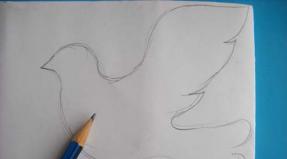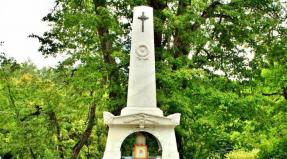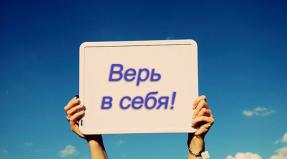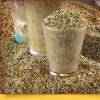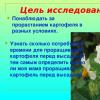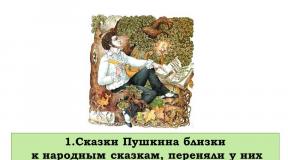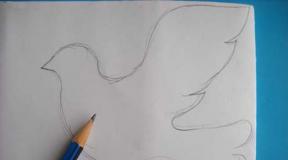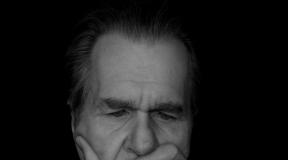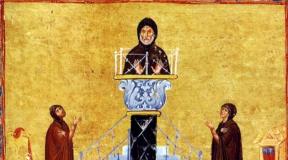“Pushkin’s fairy tale is the direct heir of the folk tale. “Pushkin’s fairy tale is a direct heir to the folk tale”
Ibragimova Ilyuza Ilgizovna
The Russian spirit is here,
It smells like Russia here...
A.S. Pushkin
I used to not move from horror,
They enchanted my sleep with deceptions,
Read it.
...And they envy
To the Sovereign's wife...
In a folk tale too:
...At this point the king could not resist,
He ordered the fleet to be equipped...
- What am I? king or child?
They apologized, burst into tears...
In a folk tale:
And I was there; honey, drank beer -
And he just wet his mustache.
...The smart guests are silent:
They don’t want to argue with the woman...
... And although the prince is angry,
But he regrets his eyes
His old grandmother...
...And the queen over the child
Like an eagle over an eaglet...
...They sit near the king,
They look like angry toads...
Project topic: Tales of A.S. Pushkin
The Russian spirit is here,
It smells like Russia here...
A.S. Pushkin
Show and (through a comparison of fairy tales) that “Pushkin’s fairy tale is the direct heir of the folk tale.”
prove that A.S. Pushkin, developing the traditions of oral folk art in a fairy tale, creates an original work that affirms universal human values.
Task: Identify similarities and differences in fairy tales. Present the material in the form of a table “Comparison of folk tales with literary tales.”
Oh, how many wonderful fairy tales surround us from childhood!
Throughout our lives, we tend to believe that evil is weaker than good, it cannot win, and that injustice will be punished. This faith arises in us when we listen to fairy tales when we are still very young.
A fairy tale is an entertaining story about extraordinary events and adventures).
They teach to distinguish good from evil, good from bad.
When we read fairy tales, they enchant; you worry about the characters, sympathize with them, admire their qualities and actions).
Close your eyes for a moment... Imagine: winter, late evening, closer to night. There is a snowstorm outside the window, and the wind is humming in the chimney. And the upper room is warm and cozy. Arina Rodionovna’s melodious voice sounds quietly, sincerely, immersing the child poet in the magical world of a folk tale.
Little Sasha does not move, he vividly imagines the fabulous events that the nanny narrates: “In a certain kingdom-state...”
The poet vividly recalled later, throughout his life, “the charm of these mysterious nights”:
I used to not move from horror,
Barely breathing, I snuggle under the blanket.
When he fell asleep, trembling with fear, his childhood creativity woke up:
Wizards and sorceresses flew away,
They enchanted my sleep with deceptions,
I got lost in a rush of sweet thoughts
* * *And the young mind rushed about in fiction...
These childhood inventions in a dream were the poet’s first creations... Therefore, we can say that Pushkin’s love for folk poetry arose under the influence of the stories of his old nanny.
As an adult, Alexander Sergeevich collected and recorded folk songs and fairy tales, and then he himself created wonderful fairy tales.
The poet himself could listen to fairy tales for hours. Pushkin based many of the folk tales he heard as the basis for his own. Today I offer you my research, that is, scientific work. In any study there is a hypothesis, that is, an assumption. I took the words of the children's writer, Samuil Yakovlevich Marshak, as a hypothesis.
Read it.
“Pushkin’s fairy tale is the direct heir of the folk tale.”
We need to prove: either this statement is true, or prove that it is not true.
Let's remember the names of Russian fairy tales.. (This is the folk tale “The sun is in the forehead, there is a month on the back of the head, there are stars on the sides” and the literary tale by A.S. Pushkin “the tale of Tsar Saltan, of his glorious and mighty hero Prince Gvidon Saltanovich and of the beautiful to the Swan Princess.")
Let's observe what is common and what is the difference between the magical folk tale “The sun is in the forehead, there is a month on the back of the head, there are stars on the sides” and the literary fairy tale by A.S. Pushkin “The Tale of Tsar Saltan, of his glorious and mighty hero Prince Guidon Saltanovich and about the beautiful Swan Princess."
: Prince Guidon is smart, resourceful, brave. The Swan Princess is kind, gentle, sympathetic, etc.
A fairy tale begins with the traditional beginning “In a certain kingdom...”. There is no such beginning in Pushkin's fairy tale.
Next comes the plot. This is an act of one or more characters, after which the action begins to develop rapidly. For example, in our fairy tales it is the evil and envy of older sisters towards the younger one. From Pushkin:
...And they envy
To the Sovereign's wife...
In a folk tale too:
...Ivan Tsarevich married his younger sister...
...And the elders began to envy her and do evil.
Then there is a story about the difficulties that befell the main characters, about their struggle against evil, about the good deeds they perform, about miracles and magical powers that help in a difficult situation. All plot actions lead to a climax.
The climax represents the main problem of the work; the characters of the characters are revealed in it very clearly. From Pushkin:
...At this point the king could not resist,
He ordered the fleet to be equipped...
- What am I? king or child?
He says, not jokingly: “I’m going now!”
Then he stamped his foot, went out and slammed the door.
Or in a folk tale: “... Tsarevich Ivan listened and thought... he felt a prick in his chest, his heart began to beat; He took off his trusty sword, took a well-aimed arrow, saddled a zealous horse and, without telling his wife “Farewell!”, flew to the palace.”
After this, the effect weakens. The denouement is coming. From Pushkin:
Here they confessed everything,
They apologized, burst into tears...
In a folk tale:
“... He found himself there, looked at the children, looked at his wife - he recognized it, and his soul brightened!”
A kind, happy ending is inherent in fairy tales. It leaves a bright feeling in the soul. This is how Pushkin’s story ends:
And I was there; honey, drank beer -
And he just wet his mustache.
In a folk tale: “At that time I was there, drinking honey and wine, seeing everything, everyone was having a lot of fun, only one older sister was sad.”
We see that the composition of fairy tales is similar; there is a beginning, plot development, climax, denouement and ending. But there were also differences: “The Tale of Tsar Saltan” is a free adaptation of a folk tale. The author freely changed and supplemented the plot, while maintaining the folk character of the content.
In the folk tale, the queen had three sons; in Pushkin’s tale, only one son.
In a folk tale, the royal sons had the sun on their foreheads, a month on the back of their heads and stars on the sides, and in Pushkin the Swan Princess had such beauty.
New heroes appear in the literary fairy tale: the villainous kite, Chernomor with the heroes, the Swan Princess and others.
The form of presentation is also different. A folk tale is written in prose, which is closer to oral literature. And “The Tale of Tsar Saltan...” is written in trochaic tetrameter with paired rhyme; in those days, “imitations” of folk poetry were often written this way. (Linguists explain the concepts of “meter”, “rhythm”, “rhyme”).
And one more important difference: in a folk tale the story is told without any relation to the characters and events. In a literary work there is an assessment of the heroes and their actions:
...The smart guests are silent:
They don’t want to argue with the woman...
... And although the prince is angry,
But he regrets his eyes
His old grandmother...
The folk tale is not so eloquent. Alexander Sergeevich Pushkin’s entire fairy tale from the first to the last lines is permeated with the magic of the plot, it enchants with every line, delights with every word. Everything is in place here and each comparison is unique in accuracy:
...And the queen over the child
Like an eagle over an eaglet...
...They sit near the king,
They look like angry toads...
Imitating oral creativity, he used epithets, constant epithets. (Linguists are working. “...sitting on a good horse...”, “...they see a hill in a wide field...” and others.
Good always triumphs over evil. Everyone gets what they deserve. At the end of the fairy tale “In the forehead of the sun...” everyone is happy, “only one older sister is bitter.” Tsar Saltan forgives everyone. He is happy and doesn't want to punish anyone. This is one of the author's ideas. You must be able to forgive offenders, to be above revenge.)
Conclusion: Pushkin’s fairy tale is close to the folk tale, it adopted from it the ideals of goodness and justice, the rejection of anger and envy!
We conducted research and compared two fairy tales. At the beginning, we put forward the assumption that Pushkin’s fairy tale is a direct heir to the folk tale.
Pushkin creates his own unique literary fairy tale.
So, we found out that Pushkin “wrote the Tale of Tsar Saltan based on the Russian folk tale “There is a sun in the forehead, a month on the back of the head, stars on the sides.” But he didn’t just retell the plot, but created his own fairy tale, in which he changed a lot, because he wanted to express his own ideals, thoughts, and ideas about life.
Download:
Preview:
To use presentation previews, create a Google account and sign in:

2. According to its mood and ideological orientation of the tale by A.S. Pushkin's works are very close to folk tales. As in folk tales, in the fairy tales of A.S. Pushkin combines the magical with reality, irony with lyricism. Events and heroes are depicted as they would be depicted in folk tales.

3. A.S. Pushkin was the first Russian poet to speak in simple folk language. This language in his fairy tales flows freely and joyfully, as if the sound of spring drops that falls into a fast-running stream sounds. The poet always admired the richness, expressiveness, and precision of the Russian language, and mastered it brilliantly.

4. A.S. Since childhood, Pushkin fell in love with folk tales, songs, and proverbs: all his life he collected, wrote down, and studied them. Already a famous poet, he had to live for two years on his father’s Pskov estate - the village of Mikhailovskoye. He spent long winter evenings with his old nanny Arina Rodionovna and, as in childhood, listened to fairy tales with enthusiasm. The life of his native people, his nanny’s fairy tales, his grandmother’s stories - all this deeply sank into the memory and soul of the great Russian poet and became the source of his own creativity.

5. The poet made some changes to the traditional fairy-tale ending (“And I was there, drinking honey, drinking beer...”). He introduced a whole series of statements: “I was”, “I drank”, “I saw”, “I sat”, “The cat... told me fairy tales.” In order to show that he entered the wonderful world of a fairy tale forever and will never part with it.


Goals of the project:
- understand and update the project topic
- find comparative material to reveal the topic of the work
- create an interested atmosphere in the class when presenting the material
- achieve understanding from listeners in disclosing the topic of the project
- to aim the audience at a love and respect for reading, and in particular for fairy tales.

Literary fairy tale – an author’s, artistic, prose or poetic work, based either on folklore sources, or purely original; the work is predominantly fantastic, magical, depicting the wonderful adventures of fairy-tale characters and, in some cases, aimed at children; a work in which magic plays the role of a plot-forming factor.

Folklore (folk) tale – An entertaining oral history of an incredible but enlightening story. The main distinguishing feature of a folk tale is the presence of miracle, fantasy, and fiction. The author of a folk tale is the people.

By literary fairy tale we mean works of three types of constructions:
- poetic tale;
- dramatic tale;
- prosaic tale.
In Russian literature, the first and second types are most common, although there are also striking examples of dramatic fairy tales.
A literary fairy tale grew out of a folk fairy tale, inheriting its features, which manifest themselves to varying degrees. Here we can talk about genre evolution.







Mineralova I.G. Children's literature. - M., 2002.
Lagin L.I. Old Man Hottabych. – Kyiv, 1988.
Ovchinnikova L.V. Specifics of the literary fairy tale genre. - M., 2001.
Lipovetsky M.N. Poetics of a literary fairy tale. - Sverdlovsk, 1992.
KGBS(K)OU "Novoaltaysk Special (Correctional) General Education Boarding SchoolIkind"
Open literature lesson in 6th grade
Topic: “Pushkin’s fairy tale is a direct descendant of the folk tale”
Leongard Tatyana Ivanovna ,
teacher of Russian language and literature
highest qualification category
Novoaltaysk
Subject: Pushkin's fairy tale is a direct descendant of the folk tale.
Target: Create conditions for comparing folk tales with literary fairy tales.
Tasks: To develop the ability to discuss events and actions of characters in comparison with facts from different works.
Develop verbal and logical thinking, long-term memory, involuntary and voluntary attention.
To instill interest in studying the works of A.S. Pushkin, to cultivate the correct attitude towards good and evil using the example of comparing the actions of heroes of folk and literary fairy tales.
Lesson type: combined lesson.
Program content:
Russian folk tale "The Frog Princess".
Russian folk tale “Morozko” (extracurricular reading).
A.S. Pushkin “The Tale of the Dead Princess and the Seven Knights.”
Reading fairy tales, working on content.
Characteristics of the main characters.
Watching the film “Morozko”, cartoons “The Frog Princess”, “The Tale of the Dead Princess and the Seven Knights”.
A multimedia installation for demonstrating educational and educational material (problematic questions and assignments for students) and visual and illustrative material (frames from the film “Morozko” and the cartoon “The Tale of the Dead Princess and the Seven Knights”).
Types of differentiated approach:
Differentiation of educational tasks according to the level of creativity (reproductive and productive tasks).
Dictionary:
heiress
frame
Organizing time.
Repetition.
What Russian folk tales have we read?
"Princess Frog"
"Morozko"
What literary fairy tale have we read?
"The Tale of the Dead Princess and the Seven Knights."
Who is the author of this fairy tale?
Alexander Sergeevich Pushkin
Portrait of Alexander Sergeevich Pushkin
We can say that “The Tale of the Dead Princess and the Seven Knights” is a Pushkin fairy tale.
Teacher's story about Pushkin.
Slide number 3 :
1824
Mikhailovskoye village
A.S. lived here in 1824. Pushkin.
Slide number 4 :
nanny and Pushkin
This is Alexander Sergeevich Pushkin and his nanny, Arina Rodionovna.
Arina Rodionovna knew a lot of folk tales and loved to tell them, and Alexander loved to listen to them.
Slide number 5:
In November 1824, in a letter to his brother, Pushkin writes: “...in the evening I listen to fairy tales. What a delight these fairy tales are!”
And then Pushkin began to write fairy tales himself.
Slide No. 6 :
“The Tale of the Priest and His Worker Balda” (1830)
“The Tale of Tsar Saltan...” (1831)
"The Tale of the Fisherman and the Fish" (1833)
"The Tale of the Dead Princess..." (1833)
"The Tale of the Golden Cockerel" (1833)
“Pushkin’s fairy tale is a direct heir to the folk tale”
S.Ya. Marshak
This is the topic of our lesson. Today you must understand the similarities between Pushkin’s fairy tales and folk tales.
Comparative analysis of literary fairy tales with folk tales.
Chant intonations
Slide number 9:
In a certain kingdom, in a certain state, there lived a king, and he had three sons. The youngest was called Ivan Tsarevich.
What kind of fairy tale is this?
Slide number 10:
Once upon a time, a grandfather lived with another wife. The grandfather had a daughter, and the woman had a daughter.
What kind of fairy tale is this?
Russian folk speech is melodious and melodic, so folk tales are read melodiously. Now read the beginning of Pushkin’s fairy tale.
Slide number 11:
The king and queen said goodbye
Prepared for the journey,
And the queen at the window
She sat down to wait for him alone.
He waits and waits from morning until night,
Looks into the field, indian eyes
They got sick looking
From white dawn until night;
I can't see my dear friend!
What kind of fairy tale is this?
Conclusion: In Pushkin's fairy tale, the melodic intonations are preserved.
Any similarities?
Word repetitions
Tsarevich Ivan thought and thought, took the frog, wrapped it in a handkerchief and brought it to his kingdom-state.
What kind of fairy tale is this?
"thought and thought"- These are repetitions of words.
Vasilisa the Wise came home and missed it - no frog skin! She rushed to look for her. I searched and searched, but couldn’t find it...
What kind of fairy tale is this?
Find repetitions.
Find repetitions in the fairy tale “Morozko”, p. 41.
thought and thought
searched, searched
take it, take it
Folk tales contain repetitions of words. Let's watch Pushkin's fairy tale. Find repetitions, p. 91-92
grew, grew
Any similarities?
Slide number 16:
Fairy-tale heroes
What heroes are there in both the fairy tale “Morozko” and “The Tale of the Dead Princess...”?
Nastenka stepdaughter princess
Any similarities?
Characters of the heroes
What is the character of an old woman? (frame)
Which queen by nature? (frame)
Character traits:
angry
rough
capricious
cruel
heartless
envious
Conclusion: Stepmothers are similar.
Now we will look at how stepmothers treat their stepdaughters.
How do stepmothers treat their stepdaughters?
What are the similarities?
The desires of the old woman and the queen to get rid of their stepdaughters are similar.
What are the personalities of stepdaughters?
Nastenka is knitting;
Nastenka talks to Morozko.
What is Nastenka like? (students characterize Nastenka)
The princess embroiders;
The princess talks to the heroes.
Which princess? (students characterize the princess)
modest
polite
cardiac
hardworking
Conclusion: The characters' characters are similar.
Slide number 22: 5. Fairy tale endings – victory of goodness and justice.
Slide number 23:
What's happened?
“Morozko” - the stepdaughter died (frozen), but then came to life, wedding feast.
“The Tale of the Dead Princess...” - the stepdaughter died - came to life - wedding feast.
Any similarities?
Slide No. 24:
6. Nature helps the heroes.
Slide number 25:
Let's remember the fairy tale "Morozko".
How does nature help Nastenka?
The cockerel and the sun help the girl finish her work before dawn.
Morozko (frost) wrapped her in warm fur coats.
Prince Elisha goes to look for his bride. He does not know where the princess is, and asks nature to help him.
To whom is Elisha speaking?
First to the sun.
Then by a month.
Then to the wind.
Conclusion: Nature helps the heroes.
Slide number 26:
Animals help good, kind people.
Slide number 27:
In the fairy tale "Morozko" the dog senses that Nastenka is in trouble and calls for help. (frame from a fairy tale).
In “The Tale of the Dead Princess...” Sokolko helps the princess (footage).
Any similarities?
Generalization.
Similarities between Pushkin's fairy tales and folk tales
Chanted intonations;
repetitions of words;
fairy-tale heroes;
characters' characters;
fairytale ending - victory of goodness and justice;
nature helps the heroes;
animals help good, kind people.
You saw that there are similarities between Pushkin's fairy tales and folk tales. Let us remember the words of Marshak:
“Pushkin’s fairy tale is a direct heir to the folk tale”
S.Ya. Marshak
VIII.Lesson summary.
What do fairy tales teach?
You cannot be angry, cruel, angry, envious.
We must be kind.
Read also...
- Children's research work on the topic "Oh, potatoes, potatoes!
- Research on the topic "the living image of the sea in the works of Russian writers and poets"
- When DNA was discovered The scientist who discovered the structure of the DNA molecule
- “Pushkin’s fairy tale is a direct heir to the folk tale”
